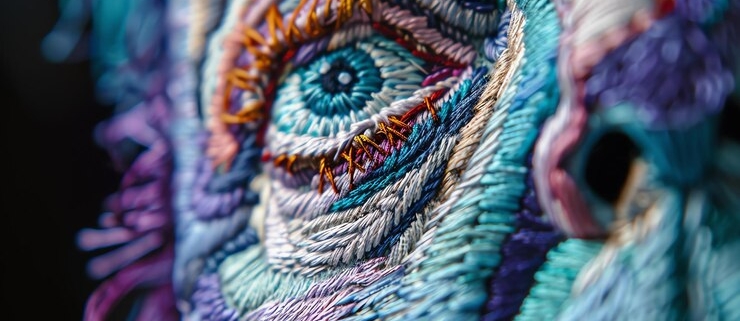The Rise of AI in Embroidery Digitizing
The world of embroidery digitizing is changing fast. Thanks to artificial intelligence (AI), what once required hours of manual work can now be done with smart tools in a fraction of the time. As industries adapt to digital transformation, embroidery businesses are also turning to AI to streamline operations, reduce costs, and improve quality.
In this blog, we’ll explore how AI is reshaping embroidery digitizing, what benefits it brings, and why companies are embracing these new solutions to stay ahead in a competitive market.
Understanding Embroidery Digitizing
Before diving into AI, it’s important to understand what embroidery digitizing means. Embroidery digitizing is the process of converting artwork into a digital file that embroidery machines can read. This file contains stitching instructions that tell the machine how to recreate the image using thread.
Traditional digitizing involves skilled professionals using special software to manually plot every stitch. This requires precision, experience, and a deep understanding of fabric types, thread tension, and machine limitations.
But with AI entering the picture, much of this complex process is now being automated.
How AI is Changing the Game
AI is transforming embroidery digitizing in several ways. From design interpretation to stitch path optimization, smart systems are helping digitizers achieve better results faster.
Here are the key areas where AI is making a difference:
1. Automatic Design Recognition
AI can analyze an image or logo and automatically recognize its components — shapes, text, and outlines. It can then recommend stitch types and layers for different parts of the design. This saves hours of guesswork and trial-and-error, especially for new digitizers.
For example, AI can detect that a circle should be filled with satin stitches while a block of text is better suited to running stitches. The software can also flag parts of the image that might not embroider well and suggest adjustments.
2. Improved Stitch Mapping
Choosing the right stitch type and direction is key to clean embroidery. AI tools learn from thousands of past designs and user corrections to predict the best stitch combinations for different elements.
This not only helps reduce thread breaks and puckering but also ensures the design runs smoothly on the machine. Stitch density, angles, and underlay can be optimized automatically based on the fabric type and design complexity.
3. Faster Turnaround Times
With AI, embroidery digitizing that once took several hours can now be done in minutes. Designers simply upload an image, select fabric type and size, and receive a ready-to-use file almost instantly. This speed helps businesses meet tight deadlines and offer same-day service to customers.
AI can also work 24/7 without fatigue, making it ideal for bulk orders or on-demand embroidery shops that operate around the clock.
Benefits for Businesses
AI-powered digitizing software brings clear benefits for embroidery businesses, whether they’re large-scale factories or small custom shops.
1. Cost Savings
Automating repetitive parts of the digitizing process reduces the need for manual labor. This lowers costs and frees up time for digitizers to focus on quality control or custom work.
Fewer errors also mean less wasted fabric and thread — leading to more efficient production and higher profit margins.
2. Consistency and Quality
AI ensures that every design is processed using the same set of rules, reducing variation in output. This consistency is especially valuable for companies that produce uniforms, branded apparel, or repeat orders for clients.
By using AI tools, even less experienced digitizers can produce professional-grade results.
3. Scalability
As customer demand grows, businesses need to scale their services. With AI, embroidery companies can handle more orders without increasing staff or infrastructure. This makes it easier to expand into new markets, serve online customers, or offer custom embroidery at scale.
AI and the Future of Creative Design
Some may worry that AI could replace the creativity of human designers. But in reality, AI is more of a partner than a competitor.
While AI can handle the technical aspects of digitizing, such as stitch count and sequencing, human designers are still needed for creative judgment, brand identity, and client communication. The best results come from combining human creativity with machine intelligence.
For example, a designer might create a logo using vector art, which ensures sharp lines and scalability. AI can then convert this vector file into a stitch-ready embroidery file, suggesting tweaks based on the fabric or use case.
This teamwork between humans and machines allows designers to focus on innovation while AI handles the mechanics.
Challenges and Limitations
Despite the benefits, AI in embroidery digitizing is not without challenges.
1. Learning Curve
Many traditional digitizers may find it difficult to trust or adapt to AI-driven tools. Training is needed to use these new platforms effectively and understand when to override AI suggestions.
2. Limited Customization
Some AI systems may offer limited control over specific elements of a design. Businesses that deal with highly customized embroidery might still need manual adjustments to meet exact client needs.
3. Software Costs
AI-powered embroidery software often comes at a premium. Smaller businesses may find the initial investment high, though many cloud-based services offer subscription models to lower entry barriers.
Choosing the Right AI Tool
If you’re considering using AI for embroidery digitizing, look for software that:
- Offers user-friendly interfaces and helpful tutorials
- Supports multiple file formats and embroidery machine types
- Allows manual adjustments alongside automated suggestions
- Provides customer support and regular updates
Well-known platforms are already integrating AI features into their embroidery design tools. Exploring these options can help businesses stay competitive and up-to-date with industry trends.
Conclusion
The rise of AI in embroidery digitizing marks a turning point in the apparel decoration industry. What once required years of experience and long hours can now be achieved faster, cheaper, and more accurately.
While AI won’t replace human desig
ners, it does offer powerful tools to help them work smarter. By combining the precision of machines with the creativity of humans, embroidery businesses can achieve more than ever before.
Whether you’re a startup or an established company, embracing AI can take your digitizing workflow to the next level — and prepare you for the future of digital embroidery.





Leave a Reply
Want to join the discussion?Feel free to contribute!